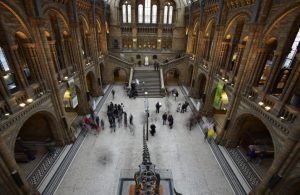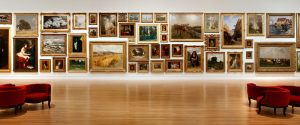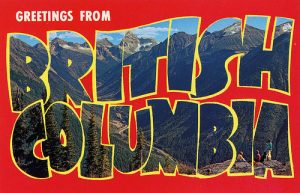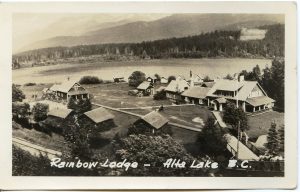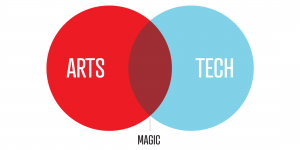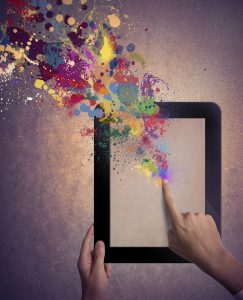Entering The Forest Primeval: New and Improved, an installation developed in residency by Atlanta sculptor Doug Fick, one is immediately aware of a figure on the floor. It is not a human form but a container for one, an amorphous chemical-protection suit made of yellow plastic with sealed gloves, boots and a hood with a transparent window through which one sees a stuffing of dead leaves. This “figure” lies, legs and arms askew, facing the back wall. The space is lit by slides, microphotographs of various species of wood stained red throwing cellular structure into relief, projected onto the full surface of this wall. The opening leading to the adjoining room is filled with a curtain of heavy orange PVC heat-formed over a tree trunk so that it bears an impression of bark pattern and curvature. This process is repeated so that vertical impressions form an undulating curtain-wall-forest. A seam allows passage to an antechamber where eyes adjust to light provided by “black light” fixtures suspended above what appears to be a dome tent. This seemingly ubiquitous type of shelter is glowing green. Bent poles constitute the skeleton whose triangular spaces are filled with wood veneer which fluoresces under the black light (caused by a naturally occurring mineral deposit in the wood).
On this simplified path one moves into the exhibition experiencing elements for the first time, in a kind of innocence. We do not know what will come next but each experience gradually conditions the last. On turning to leave, the experience is quite different. One has an inkling of a whole, a desire to pull things together, to create a closure by building a narrative, imposing a metaphorical or allegorical order, somehow creating a common ground between the fragments. The intentionality of Fick’s material transformations and choices of imagery, where nothing seems accidental, draws an intensity of focus. This focus creates a desire for a similar rigour of interpretation, but the elements do not fall into place as easily as we would wish. The narrative remains fractured and meaning diffuses in a general air of disturbance.
In our daily experience we rely on our senses to collect information, interpreting from within the narrow limits of what we can see, hear, smell, etc. Technology extends this realm allowing us to perceive, separate and name that which is beyond the reach of our senses. A microscopic sample is dyed so that we can see its structure, the process transforming the substance (the microphotographs). Light of a specific wavelength is isolated and used to expose a material not otherwise visible to the eye (the fluorescent tent). Transformation, turning one form of energy into another or using one chemical substance to mark another, is a fundamental technique of science bringing the range of the invisible into the spectrum of the quantifible where elements can be identified and made useful. This most basic techne also brings an awareness that our senses are no longer adequate for the world in which we live. The glowing green of the tent is reminiscent of the stereotypical sign for radioactivity, a range of energy which, like many invisible dangers (chemicals, energy, bacteria, etc.) our senses simply cannot detect. In a world without technology these dangers would remain unnamable. Have we exchanged one form of alienation in relation to nature for another (the unknown for the undetectable)?
In mimicking this technological epistemology and technique, Fick replicates a common artistic strategy of material transformation which focuses this work on how we perceive and order things. There is a dialogue between the invisible, the made-visible and transformed. We are made aware of the infinite gradation between the unknown and the known, casting doubt on the iceberg-tip of the supposedly verifiable. Everything is in a state of self-contradiction in terms of representation. No object in this mise-en-scene is as it should be. The figure is made of dead vegetation sealed in a plastic skin. The forest, in an inside-out metonymy, is a rubbery serial impression in orange plastic, imitating the process of mass-production. The dysfunctional tent, on the other hand, is made of real wood.
Programa de residencia para artistas en Los Angeles
If transformation for scientific purposes serves to clarify identification then these sculptural transformations question our perception of the object. Signification is somehow separated from physical matter. Imagine this exhibition if Fick had brought a real tent and trees into the gallery or if the elements were sincere and skillful imitations of that which they were supposed to represent. Neither of these possibilities would fulfill Fick. These works are neither “true” things nor props. They have been pushed into some other order. Traditional methods have been used in effecting transformations which take these objects out of the range of the everyday and makes them into objects of wonder – not some magical state but rather a state where the factors that make them perceptible and comprehensible, which bring them into the “knowable,” are pushed onto the surface. Neither completely “things” nor representations, they propose the question what constitutes a “thing”?
In Fick’s sculpture the industrial processes of molds and matrices reinforce their “madeness.” The transformation emphasizes our separateness from nature or essence and the futility of simple representation. Our relationship to any “real” or Arcadian “nature” is defined by the technology of “seeing” and making over that which we have mastery. Nature is only real to us under the light we can cast on it. The installation as a whole reproduces the same process of distancing from the “original” evident in each sculptural component, questioning how we embody and represent nature and probing the wavering parameters of perception and experience. The deliberateness of Fick’s transformations creates a complex engagement with the work which is quite rare. Too often, in contemporary practice, material choices are off-hand, perhaps clever or startling but without depth or rigour. In this work there is a seriousness of making which goes beyond stylistic exoticism to throw some light on the nature of experience.

